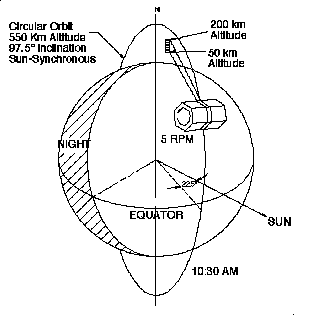Mission Overview
 The Student Nitric Oxide Explorer (SNOE) was a small scientific spacecraft designed, built, and operated by the University of Colorado at Boulder, Laboratory for Atmospheric and Space Physics (LASP). Its scientific goals are to measure nitric oxide density in the terrestrial lower thermosphere (100-200 km altitude) and analyze the energy inputs to that region from the sun and magnetosphere that create it and cause its abundance to vary dramatically. The SNOE spacecraft was a compact hexagonal structure, 36” high and 39” across its widest dimension, that weighs 254 lbs. It was launched by a Pegasus XL into a circular orbit, 580 km altitude, at 97.75 degrees inclination for sun synchronous precession, on 26 Feb. 1998. It spins at 5 rpm with the spin axis normal to the orbit plane. It carried three instruments: an ultraviolet spectrometer to measure nitric oxide altitude profiles, a two-channel auroral photometer to measure auroral emissions beneath the spacecraft, and a five-channel solar soft X-ray photometer. Charles Barth wa the principal investigator, and Stan Solomon was the deputy principal investigator of the SNOE project. SNOE was one of three satellite projects selected for the Student Explorer Demonstration Initiative program (STEDI). STEDI was funded by NASA and managed by the Universities Space Research Association (USRA).
The Student Nitric Oxide Explorer (SNOE) was a small scientific spacecraft designed, built, and operated by the University of Colorado at Boulder, Laboratory for Atmospheric and Space Physics (LASP). Its scientific goals are to measure nitric oxide density in the terrestrial lower thermosphere (100-200 km altitude) and analyze the energy inputs to that region from the sun and magnetosphere that create it and cause its abundance to vary dramatically. The SNOE spacecraft was a compact hexagonal structure, 36” high and 39” across its widest dimension, that weighs 254 lbs. It was launched by a Pegasus XL into a circular orbit, 580 km altitude, at 97.75 degrees inclination for sun synchronous precession, on 26 Feb. 1998. It spins at 5 rpm with the spin axis normal to the orbit plane. It carried three instruments: an ultraviolet spectrometer to measure nitric oxide altitude profiles, a two-channel auroral photometer to measure auroral emissions beneath the spacecraft, and a five-channel solar soft X-ray photometer. Charles Barth wa the principal investigator, and Stan Solomon was the deputy principal investigator of the SNOE project. SNOE was one of three satellite projects selected for the Student Explorer Demonstration Initiative program (STEDI). STEDI was funded by NASA and managed by the Universities Space Research Association (USRA).
The Spacecraft
Weight: 254 lbs
Power Consumption: 35 W (orbit average)
Data Rate: 6 MB/Day
Information
For information on the spacecraft and instrument design and on the individual subsystems, see the SNOE Project Library. Pictures, high-resolution graphics, and a few movies can be found in the Project Activity archives.
Students were involved in all aspects of the project. Under the supervision of LASP and industry mentors, they worked on the design study, built the spacecraft and instruments, wrote the flight software, integrated and tested the instruments and subsystems, and integrated with the launch vehicle. SNOE was operated from the LASP Space Technology Research building by a team of students and mission operations professionals. Advanced undergraduates and graduate students analyzed the data. The student training effort was coordinated through a course offered continuously in the CU Department of Aerospace Engineering Sciences.
